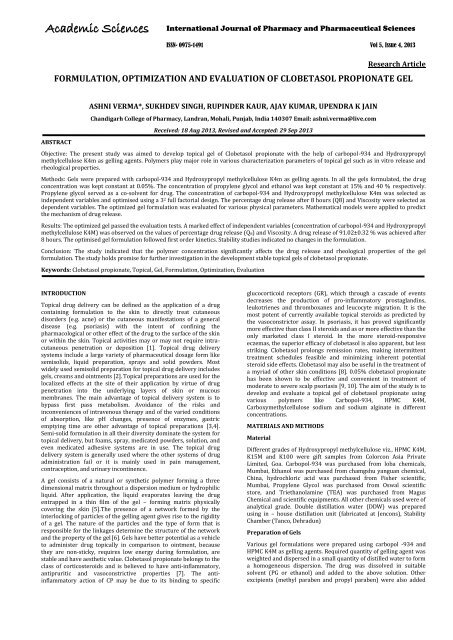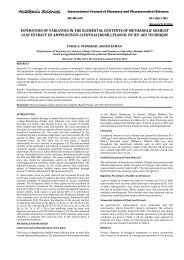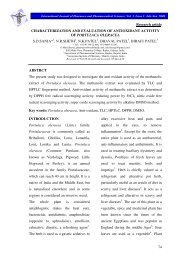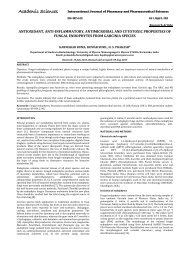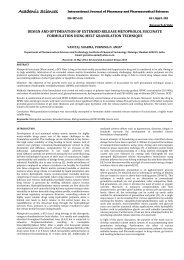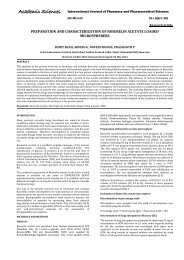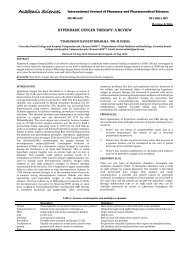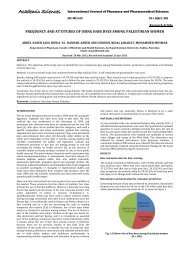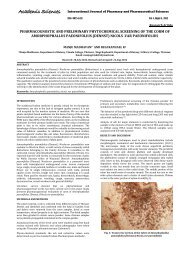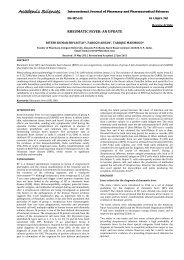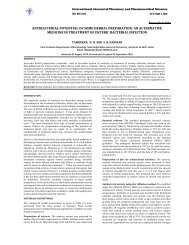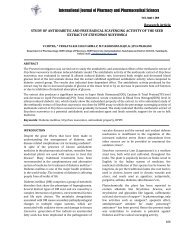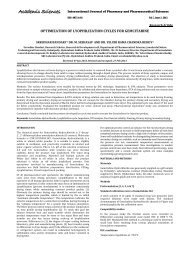formulation, optimization and evaluation of clobetasol propionate gel
formulation, optimization and evaluation of clobetasol propionate gel
formulation, optimization and evaluation of clobetasol propionate gel
Create successful ePaper yourself
Turn your PDF publications into a flip-book with our unique Google optimized e-Paper software.
Academic Sciences<br />
International Journal <strong>of</strong> Pharmacy <strong>and</strong> Pharmaceutical Sciences<br />
ISSN- 0975-1491 Vol 5, Issue 4, 2013<br />
Research Article<br />
FORMULATION, OPTIMIZATION AND EVALUATION OF CLOBETASOL PROPIONATE GEL<br />
ABSTRACT<br />
ASHNI VERMA*, SUKHDEV SINGH, RUPINDER KAUR, AJAY KUMAR, UPENDRA K JAIN<br />
Ch<strong>and</strong>igarh College <strong>of</strong> Pharmacy, L<strong>and</strong>ran, Mohali, Punjab, India 140307 Email: ashni.verma@live.com<br />
Received: 18 Aug 2013, Revised <strong>and</strong> Accepted: 29 Sep 2013<br />
Objective: The present study was aimed to develop topical <strong>gel</strong> <strong>of</strong> Clobetasol <strong>propionate</strong> with the help <strong>of</strong> carbopol-934 <strong>and</strong> Hydroxypropyl<br />
methylcellulose K4m as <strong>gel</strong>ling agents. Polymers play major role in various characterization parameters <strong>of</strong> topical <strong>gel</strong> such as in vitro release <strong>and</strong><br />
rheological properties.<br />
Methods: Gels were prepared with carbopol-934 <strong>and</strong> Hydroxypropyl methylcellulose K4m as <strong>gel</strong>ling agents. In all the <strong>gel</strong>s formulated, the drug<br />
concentration was kept constant at 0.05%. The concentration <strong>of</strong> propylene glycol <strong>and</strong> ethanol was kept constant at 15% <strong>and</strong> 40 % respectively.<br />
Propylene glycol served as a co-solvent for drug. The concentration <strong>of</strong> carbopol-934 <strong>and</strong> Hydroxypropyl methylcellulose K4m was selected as<br />
independent variables <strong>and</strong> optimised using a 3 2 full factorial design. The percentage drug release after 8 hours (Q8) <strong>and</strong> Viscosity were selected as<br />
dependent variables. The optimized <strong>gel</strong> <strong>formulation</strong> was evaluated for various physical parameters. Mathematical models were applied to predict<br />
the mechanism <strong>of</strong> drug release.<br />
Results: The optimized <strong>gel</strong> passed the <strong>evaluation</strong> tests. A marked effect <strong>of</strong> independent variables (concentration <strong>of</strong> carbopol-934 <strong>and</strong> Hydroxypropyl<br />
methylcellulose K4M) was observed on the values <strong>of</strong> percentage drug release (Q8) <strong>and</strong> Viscosity. A drug release <strong>of</strong> 91.02±0.32 % was achieved after<br />
8 hours. The optimised <strong>gel</strong> <strong>formulation</strong> followed first order kinetics. Stability studies indicated no changes in the <strong>formulation</strong>.<br />
Conclusion: The study indicated that the polymer concentration significantly affects the drug release <strong>and</strong> rheological properties <strong>of</strong> the <strong>gel</strong><br />
<strong>formulation</strong>. The study holds promise for further investigation in the development stable topical <strong>gel</strong>s <strong>of</strong> <strong>clobetasol</strong> <strong>propionate</strong>.<br />
Keywords: Clobetasol <strong>propionate</strong>, Topical, Gel, Formulation, Optimization, Evaluation<br />
INTRODUCTION<br />
Topical drug delivery can be defined as the application <strong>of</strong> a drug<br />
containing <strong>formulation</strong> to the skin to directly treat cutaneous<br />
disorders (e.g. acne) or the cutaneous manifestations <strong>of</strong> a general<br />
disease (e.g. psoriasis) with the intent <strong>of</strong> confining the<br />
pharmacological or other effect <strong>of</strong> the drug to the surface <strong>of</strong> the skin<br />
or within the skin. Topical activities may or may not require intracutaneous<br />
penetration or deposition [1]. Topical drug delivery<br />
systems include a large variety <strong>of</strong> pharmaceutical dosage form like<br />
semisolids, liquid preparation, sprays <strong>and</strong> solid powders. Most<br />
widely used semisolid preparation for topical drug delivery includes<br />
<strong>gel</strong>s, creams <strong>and</strong> ointments [2]. Topical preparations are used for the<br />
localized effects at the site <strong>of</strong> their application by virtue <strong>of</strong> drug<br />
penetration into the underlying layers <strong>of</strong> skin or mucous<br />
membranes. The main advantage <strong>of</strong> topical delivery system is to<br />
bypass first pass metabolism. Avoidance <strong>of</strong> the risks <strong>and</strong><br />
inconveniences <strong>of</strong> intravenous therapy <strong>and</strong> <strong>of</strong> the varied conditions<br />
<strong>of</strong> absorption, like pH changes, presence <strong>of</strong> enzymes, gastric<br />
emptying time are other advantage <strong>of</strong> topical preparations [3,4].<br />
Semi-solid <strong>formulation</strong> in all their diversity dominate the system for<br />
topical delivery, but foams, spray, medicated powders, solution, <strong>and</strong><br />
even medicated adhesive systems are in use. The topical drug<br />
delivery system is generally used where the other systems <strong>of</strong> drug<br />
administration fail or it is mainly used in pain management,<br />
contraception, <strong>and</strong> urinary incontinence.<br />
A <strong>gel</strong> consists <strong>of</strong> a natural or synthetic polymer forming a three<br />
dimensional matrix throughout a dispersion medium or hydrophilic<br />
liquid. After application, the liquid evaporates leaving the drug<br />
entrapped in a thin film <strong>of</strong> the <strong>gel</strong> – forming matrix physically<br />
covering the skin [5].The presence <strong>of</strong> a network formed by the<br />
interlocking <strong>of</strong> particles <strong>of</strong> the <strong>gel</strong>ling agent gives rise to the rigidity<br />
<strong>of</strong> a <strong>gel</strong>. The nature <strong>of</strong> the particles <strong>and</strong> the type <strong>of</strong> form that is<br />
responsible for the linkages determine the structure <strong>of</strong> the network<br />
<strong>and</strong> the property <strong>of</strong> the <strong>gel</strong> [6]. Gels have better potential as a vehicle<br />
to administer drug topically in comparison to ointment, because<br />
they are non-sticky, requires low energy during <strong>formulation</strong>, are<br />
stable <strong>and</strong> have aesthetic value. Clobetasol <strong>propionate</strong> belongs to the<br />
class <strong>of</strong> corticosteroids <strong>and</strong> is believed to have anti-inflammatory,<br />
antipruritic <strong>and</strong> vasoconstrictive properties [7]. The antiinflammatory<br />
action <strong>of</strong> CP may be due to its binding to specific<br />
glucocorticoid receptors (GR), which through a cascade <strong>of</strong> events<br />
decreases the production <strong>of</strong> pro-inflammatory prostagl<strong>and</strong>ins,<br />
leukotrienes <strong>and</strong> thromboxanes <strong>and</strong> leucocyte migration. It is the<br />
most potent <strong>of</strong> currently available topical steroids as predicted by<br />
the vasoconstrictor assay. In psoriasis, it has proved significantly<br />
more effective than class II steroids <strong>and</strong> as or more effective than the<br />
only marketed class I steroid. In the more steroid-responsive<br />
eczemas, the superior efficacy <strong>of</strong> <strong>clobetasol</strong> is also apparent, but less<br />
striking. Clobetasol prolongs remission rates, making intermittent<br />
treatment schedules feasible <strong>and</strong> minimizing inherent potential<br />
steroid side effects. Clobetasol may also be useful in the treatment <strong>of</strong><br />
a myriad <strong>of</strong> other skin conditions [8]. 0.05% <strong>clobetasol</strong> <strong>propionate</strong><br />
has been shown to be effective <strong>and</strong> convenient in treatment <strong>of</strong><br />
moderate to severe scalp psoriasis [9, 10]. The aim <strong>of</strong> the study is to<br />
develop <strong>and</strong> evaluate a topical <strong>gel</strong> <strong>of</strong> <strong>clobetasol</strong> <strong>propionate</strong> using<br />
various polymers like Carbopol-934, HPMC K4M,<br />
Carboxymethylcellulose sodium <strong>and</strong> sodium alginate in different<br />
concentrations.<br />
MATERIALS AND METHODS<br />
Material<br />
Different grades <strong>of</strong> Hydroxypropyl methylcellulose viz., HPMC K4M,<br />
K15M <strong>and</strong> K100 were gift samples from Colorcon Asia Private<br />
Limited, Goa. Carbopol-934 was purchased from loba chemicals,<br />
Mumbai, Ethanol was purchased from chamgshu yanguan chemical,<br />
China, hydrochloric acid was purchased from Fisher scientific,<br />
Mumbai, Propylene Glycol was purchased from Oswal scientific<br />
store, <strong>and</strong> Triethanolamine (TEA) was purchased from Magus<br />
Chemical <strong>and</strong> scientific equipments. All other chemicals used were <strong>of</strong><br />
analytical grade. Double distillation water (DDW) was prepared<br />
using in – house distillation unit (fabricated at Jencons), Stability<br />
Chamber (Tanco, Dehradun)<br />
Preparation <strong>of</strong> Gels<br />
Various <strong>gel</strong> <strong>formulation</strong>s were prepared using carbopol -934 <strong>and</strong><br />
HPMC K4M as <strong>gel</strong>ling agents. Required quantity <strong>of</strong> <strong>gel</strong>ling agent was<br />
weighted <strong>and</strong> dispersed in a small quantity <strong>of</strong> distilled water to form<br />
a homogeneous dispersion. The drug was dissolved in suitable<br />
solvent (PG or ethanol) <strong>and</strong> added to the above solution. Other<br />
excipients (methyl paraben <strong>and</strong> propyl paraben) were also added
Verma et al.<br />
Int J Pharm Pharm Sci, Vol 5, Issue 4, 666-674<br />
with continuous stirring. The pH <strong>of</strong> the <strong>gel</strong>s was brought to skin pH<br />
by TEA. The final weight <strong>of</strong> the <strong>gel</strong> was adjusted to 50 grams with<br />
distilled water. The <strong>gel</strong>s were stored in wide mouthed bottles.<br />
Entrapped air bubbles were removed by keeping the <strong>gel</strong>s in vacuum<br />
oven for 2 hours. The composition <strong>of</strong> various <strong>gel</strong> <strong>formulation</strong>s is<br />
shown in Table No.2<br />
Optimisation <strong>of</strong> Gel <strong>formulation</strong><br />
The experimental design was a two factor three level (3 2 ) full<br />
factorial design (FD) <strong>and</strong> nine <strong>formulation</strong>s were prepared. The<br />
amount <strong>of</strong> polymers X1 (HPMC K4M) <strong>and</strong> X2 (carbopol -934) were<br />
selected as independent variables. The amount <strong>of</strong> polymers was<br />
optimised for dependent variables: Drug release after 8 hours <strong>and</strong><br />
viscosity <strong>of</strong> <strong>gel</strong>s. The low (-1), medium (0) <strong>and</strong> high (1) are the<br />
values <strong>of</strong> X1 (HPMC K4M) <strong>and</strong> X2 (carbopol -934) respectively. Nine<br />
batches were formulated as shown in Table 2. In a full FD, all the<br />
factors are studied in all possible combinations, as it is considered to<br />
be most efficient in estimating the influence <strong>of</strong> individual variables<br />
<strong>and</strong> their interaction using minimum experimentation. In the<br />
present study the responses were analysed for ANOVA using design<br />
expert s<strong>of</strong>tware (trial version 8.0.7). A mathematical equation was<br />
generated for each parameter. The mathematical model was studied<br />
for significance. Response surface plots were generated for each<br />
response to study the behaviour <strong>of</strong> the system.<br />
Generation <strong>of</strong> statistical models<br />
A statistical model, Y= incorporating interactive <strong>and</strong> polynomial<br />
terms was used to evaluate the responses; where Y is the dependent<br />
variable, is the arithmetic mean response <strong>of</strong> the nine runs <strong>and</strong> is the<br />
estimated coefficient for the factor X. The main effects (X1 <strong>and</strong> X2)<br />
represent the average result <strong>of</strong> changing one factor between two<br />
factors.<br />
Optimum <strong>formulation</strong> for topical <strong>gel</strong> <strong>of</strong> <strong>clobetasol</strong> <strong>propionate</strong><br />
Gels were prepared as method described earlier. The composition <strong>of</strong><br />
optimized <strong>formulation</strong> (F10) <strong>of</strong> the <strong>gel</strong> is tabulated in Table 8.<br />
Development <strong>of</strong> optimized topical <strong>gel</strong><br />
The optimized <strong>gel</strong> was prepared with the best amount <strong>of</strong> polymers<br />
suggested by the design expert s<strong>of</strong>tware (demo version 8.0.7). The<br />
prepared <strong>gel</strong>s were evaluated for its physiochemical properties viz.<br />
Homogeneity, grittiness, spreadability, viscosity, Ph measurement,<br />
drug content <strong>and</strong> In-vitro drug diffusion studies. The procedures for<br />
the above mentioned properties are described below. The results<br />
are shown in Table 8 <strong>and</strong> 9.<br />
Evaluation <strong>of</strong> Gels<br />
A. pH Measurement [11]<br />
The pH <strong>of</strong> various <strong>gel</strong> <strong>formulation</strong>s was determined by using digital<br />
pH meter.1 g <strong>of</strong> <strong>gel</strong> was dissolved in 100 mL freshly prepared<br />
distilled water <strong>and</strong> stored for two hours. The measurement <strong>of</strong> pH <strong>of</strong><br />
each <strong>formulation</strong> was done in triplicate <strong>and</strong> average values are<br />
calculated.<br />
B. Homogeneity [12]<br />
All developed <strong>gel</strong>s were tested for homogeneity by visual inspection<br />
after the <strong>gel</strong>s have been set in the container.<br />
C. Grittiness [13]<br />
Smears <strong>of</strong> <strong>gel</strong>s were prepared on glass slide <strong>and</strong> observed under the<br />
microscope for the presence <strong>of</strong> any particle or grittiness.<br />
D. Viscosity Measurement [12, 14]<br />
Brookfield digital viscometer was used to measure the viscosity <strong>of</strong><br />
prepared <strong>gel</strong> <strong>formulation</strong>s. The spindle no. 6 was rotated at 10 rpm.<br />
The reading, near to 100 % torque was noted. Samples were<br />
measured at 30 ± 1 °C.<br />
E. Spreadability [15]<br />
One <strong>of</strong> the criteria for a <strong>gel</strong> to meet the ideal quantities is that it<br />
should possess good spreadability. It is the term expressed to<br />
denote the extent <strong>of</strong> area to which <strong>gel</strong> readily spreads on<br />
application. The therapeutic efficacy <strong>of</strong> a <strong>formulation</strong> also depends<br />
upon its spreading value. It was determined by wooden block <strong>and</strong><br />
glass slide apparatus. Weights <strong>of</strong> about 2 g were added to the pan<br />
<strong>and</strong> the time was noted for upper slide (movable) to separate<br />
completely from the fixed slides. Spreadability was then calculated<br />
by using the formula:<br />
S = M.L / T<br />
Where,<br />
S = Spreadability<br />
M = Weight tide to the upper slide<br />
L = Length <strong>of</strong> a glass slide<br />
T = Time taken to separate the slide completely from each other.<br />
F. Drug content [16, 17]<br />
A specific quantity (1 g) <strong>of</strong> developed <strong>gel</strong> was taken <strong>and</strong> dissolved in<br />
100mL <strong>of</strong> phosphate buffer <strong>of</strong> pH 7.4. The volumetric flask containing<br />
<strong>gel</strong> solution was shaken for 2 h on mechanical shaker in order to get<br />
complete solubility <strong>of</strong> drug. The solution was filtered through 0.45 μm<br />
membrane filter <strong>and</strong> estimated spectrophotometrically at 293 nm<br />
using phosphate buffer (pH 7.4) as blank.<br />
G. In-vitro Drug Diffusion Study [18]<br />
In-vitro drug release studies were performed by using a modified<br />
Franz diffusion cell with a receptor compartment capacity <strong>of</strong> 20 ml.<br />
The synthetic cellophane membrane was mounted between the<br />
donor <strong>and</strong> receptor compartment <strong>of</strong> the diffusion cell. The<br />
formulated <strong>gel</strong>s were weight up to 1 g <strong>and</strong> placed over the drug<br />
release membrane <strong>and</strong> the receptor compartment <strong>of</strong> the diffusion<br />
cell was filled with phosphate buffer pH 7.4. The whole assembly<br />
was fixed on a magnetic stirrer, <strong>and</strong> the solution in the receptor<br />
compartment was constantly <strong>and</strong> continuously stirred using<br />
magnetic beads at 50 RPM; the temperature was maintained at 37 ±<br />
0.50 °C. The samples <strong>of</strong> 1 mL were withdrawn at time interval <strong>of</strong> 30,<br />
60, 90, 120, 150, 180, 210, 240, 270, 300, 330, 360, 390, 420, 450<br />
<strong>and</strong> 480 minutes <strong>and</strong> analysed for drug content<br />
spectrophotometrically at 240 nm against blank. The receptor phase<br />
was replenished with an equal volume <strong>of</strong> phosphate buffer at each<br />
time <strong>of</strong> sample withdrawal. The cumulative amounts <strong>of</strong> drug<br />
diffused from <strong>gel</strong>s were plotted against time.<br />
Mechanism <strong>of</strong> Drug Release [19]<br />
Various models were tested for explaining the kinetics <strong>of</strong> drug<br />
release. To analyse the mechanism <strong>of</strong> the drug release rate kinetics<br />
<strong>of</strong> the dosage form, the obtained data were fitted into zero-order,<br />
first order, Higuchi, Hixon- Crowell model <strong>and</strong> Korsmeyer-Peppas<br />
release model.<br />
Zero order release rate kinetics<br />
To study the zero–order release kinetics the release rate data are<br />
fitted to the following equation.<br />
F = K0.t………………………….…………………………………...... (Eq. 1)<br />
Where ‘F’ is the drug release, ‘K0’ is the release rate constant <strong>and</strong> ‘t’<br />
is the release time. The plot <strong>of</strong> percentage drug release versus time<br />
is linear.<br />
First order release rate kinetics<br />
The release rate date are fitted to the following equation<br />
Log (100 – F) = K t…………………………………………..……. (Eq. 2)<br />
A plot <strong>of</strong> log % drug release versus time is linear.<br />
Higuchi release model<br />
To study the Higuchi release kinetics, the release rate data were<br />
fitted to the following equation, where, ‘k’ is the Higuchi constant. In<br />
higuchi model, a plot <strong>of</strong> percentage drug release versus square root<br />
<strong>of</strong> time is linear.<br />
667
Verma et al.<br />
Int J Pharm Pharm Sci, Vol 5, Issue 4, 666-674<br />
Hixon-Crowell model<br />
To study the Hixon-Crowell release kinetics, the release rate data<br />
were fitted to the following equation,<br />
W0 1/3 – Wt 1/3 = k t………………………...……………………..… (Eq. 3)<br />
Where, ‘Wo’ is the original mass/weight <strong>of</strong> drug, ‘Wt’ is the<br />
mass/weight at‘t’ time, ‘k’ is Hixon-Crowell constant. In this model<br />
(Wo 1/3 – Wt 1/3 ) versus time is linear.<br />
Korsmeyer <strong>and</strong> Peppas release model:<br />
The release rate data were fitted to the following equation, Where,<br />
Mt /Mµ is fraction <strong>of</strong> drug released ‘k’ is the release constant, ‘t’ is<br />
the release time, ‘n’ is diffusion exponent, if n is equal to 0.89, the<br />
release is zero order. If n is equal to 0.45 the release is best<br />
explained by Fickian diffusion, <strong>and</strong> if 0.45 < n < 0.89 then the release<br />
is through anomalous diffusion or non-fickian diffusion (swellable<br />
<strong>and</strong> cylinder Matrix). In this model, a plot <strong>of</strong> log (Mt/Mµ) versus log<br />
(time) is linear. The data from In-Vitro Drug diffusion studies <strong>of</strong> <strong>gel</strong>s<br />
was fitted to Zero-order, First order, Higuchi, Hixon- Crowell, <strong>and</strong><br />
Korsmeyer- Peppas model to study the kinetics <strong>of</strong> drug release.<br />
Stability Study [20, 21]<br />
In order to access the long term stability, the optimised <strong>gel</strong> <strong>of</strong><br />
<strong>clobetasol</strong> <strong>propionate</strong> was packed in aluminium collapsible tubes<br />
<strong>and</strong> stored at (40 ± 2ºC/75 ±5% RH) for a period <strong>of</strong> three months.<br />
The test conditions are given in Table 1.<br />
The <strong>gel</strong>s was withdrawn after a period <strong>of</strong> 15 days <strong>and</strong> analysed for<br />
physical characterisation <strong>and</strong> drug content spectrophotometrically<br />
at 240 nm. The data obtained was fitted into the first order<br />
equations to determine the kinetics <strong>of</strong> degradation. The diffusion<br />
pr<strong>of</strong>ile <strong>of</strong> optimised <strong>gel</strong>s was also compared. The diffusion similarity<br />
factor (f2) was also calculated to compare before <strong>and</strong> after storage<br />
diffusion pr<strong>of</strong>ile. In recent years, FDA has placed more emphasis on<br />
diffusion pr<strong>of</strong>ile comparison in the area <strong>of</strong> post-approval changes<br />
<strong>and</strong> bio waivers. Under appropriate test conditions, a diffusion<br />
pr<strong>of</strong>ile can characterise the product more precisely than a single<br />
point diffusion test. A diffusion pr<strong>of</strong>ile comparison between prechange<br />
<strong>and</strong> post- change products for Scale-up <strong>and</strong> post approval<br />
changes SUPAC related changes, or with different strengths, helps<br />
assure similarity in product performance <strong>and</strong> signals<br />
bioequivalence.<br />
Among several methods investigated for diffusion pr<strong>of</strong>ile<br />
comparison, f2 is the simplest.<br />
f1= {[∑t=1 n | Rt-Tt|]/ [∑ t=1nRt]}.100……………………..…… (Eq. 4)<br />
f2=50.log {[1+1/n] ∑t=1 n (Rt−Tt) 2 ] −0.5 .100}…………….…(Eq. 5)<br />
Where, R1 <strong>and</strong> T1 are the cumulative percentage dissolved at each <strong>of</strong><br />
the selected n time points <strong>of</strong> the reference <strong>and</strong> test product<br />
respectively. When the two pr<strong>of</strong>iles are identical, f2 = 100. An<br />
average difference <strong>of</strong> 10 % at all measured time points result in an f2<br />
value <strong>of</strong> 50. FDA has set a public st<strong>and</strong>ard <strong>of</strong> an f2 value <strong>of</strong> 50 to 100<br />
which indicates similarity between two diffusion pr<strong>of</strong>iles.<br />
Table 1: It shows test conditions for stability studies<br />
Accelerated stability<br />
Testing conditions<br />
Temperature conditions* ( º ) 40±2<br />
Relative humidity conditions* 75±5<br />
(%)<br />
Frequency <strong>of</strong> testing samples 0, 15, 30, 45, 60, 75 <strong>and</strong> 90<br />
days<br />
º denotes degree Celsius, % is percentage. * indicates Value ± SD<br />
where S.D = st<strong>and</strong>ard deviation<br />
RESULTS AND DISCUSSION<br />
The results shown in Table 4 clears that the Q8 <strong>and</strong> viscosity have a<br />
significant effect on the <strong>gel</strong>s prepared. The use <strong>of</strong> carbopol-934 <strong>and</strong><br />
HPMC K4M in combination resulted in better drug release <strong>and</strong><br />
viscosity pr<strong>of</strong>iles <strong>of</strong> <strong>gel</strong>s were also improved. By evaluating these<br />
<strong>gel</strong>s, the levels for the optimisation <strong>of</strong> the independent factors were<br />
to be set. The three levels (-1, low: 0, medium: +1, high) <strong>of</strong> carbopol-<br />
934 <strong>and</strong> HPMC K4M were selected.<br />
Table 2: It shows <strong>formulation</strong>s according to factorial design level<br />
Ingredients F1 F2 F3 F4 F5 F6 F7 F8 F9<br />
Drug 0.05 0.05 0.05 0.05 0.05 0.05 0.05 0.05 0.05<br />
Carbopol - 934 0.5 0.5 0.5 1.0 1.0 1.0 1.5 1.5 1.5<br />
HPMC K4M 0.5 1.0 1.5 0.5 1.0 1.5 0.5 1.0 1.5<br />
Propylene glycol 15 15 15 15 15 15 15 15 15<br />
Ethanol 40 40 40 40 40 40 40 40 40<br />
Methyl paraben 0.3 0.3 0.3 0.3 0.3 0.3 0.3 0.3 0.3<br />
Propyl paraben 0.6 0.6 0.6 0.6 0.6 0.6 0.6 0.6 0.6<br />
Triethanolamine Q.S Q.S Q.S Q.S Q.S Q.S Q.S Q.S Q.S<br />
Water Q.S Q.S Q.S Q.S Q.S Q.S Q.S Q.S Q.S<br />
*All Quantities are in percentage (%); Q.S is Quantity sufficient.<br />
Table 3: It shows characterization <strong>of</strong> <strong>gel</strong>s (F1 – F9)<br />
Parameters → Homogeneity Grittiness pH<br />
Formulations ↓<br />
F1 +++ - 6.9<br />
F2 +++ - 7.1<br />
F3 +++ - 7.0<br />
F4 ++ - 7.0<br />
F5 +++ - 7.2<br />
F6 ++ - 6.9<br />
F7 ++ - 7.0<br />
F8 ++ - 6.9<br />
F9 ++ - 7.1<br />
+ Satisfactory, ++ good, +++ Very good; - no grittiness<br />
668
Verma et al.<br />
Int J Pharm Pharm Sci, Vol 5, Issue 4, 666-674<br />
Table 4: It shows characterization <strong>of</strong> <strong>gel</strong>s (F1 – F9)<br />
Parameters* → Spreadability Percentage Drug Content Percentage Drug Release after 8 hours (Q8) Viscosity<br />
Formulations ↓ (g.cm/s)<br />
(cps)<br />
F1 38.98±0.56 99.6±0.2 93.56±2.7 18980±19<br />
F2 36.26±0.68 99.3±0.2 88.98±2.1 23039±17<br />
F3 33.29±1.89 98.9±0.5 85.69±2.0 24129±13<br />
F4 32.65±1.14 99.1±0.2 79.61±2.6 26374±10<br />
F5 31.25±0.62 98.6±0.1 78.47±3.1 27324±14<br />
F6 28.97±0.29 99.2±0.3 76.39±2.2 28926±23<br />
F7 27.49±0.48 99.7±0.1 73.26±2.5 32386±15<br />
F8 26.54±0.32 99.1±0.3 71.15±3.2 34248±22<br />
F9 25.78±0.58 98.6±0.4 69.89±2.4 35390±24<br />
* means that each value is average <strong>of</strong> three independent determinations <strong>and</strong> is presented as Mean ±S.D.<br />
S.D= st<strong>and</strong>ard deviation; g.cm/s = grams centimetre per second; cps = centipoise<br />
Batch no. F1 – F9 were prepared using different concentrations <strong>of</strong><br />
carbopol-934, HPMC K4M in the concentration range <strong>of</strong> 0.5-1.5 %.<br />
The data for physiochemical characterization <strong>of</strong> these batches is<br />
shown in Table 3 <strong>and</strong> 4.<br />
In order to investigate the factors systematically <strong>and</strong> optimize the<br />
<strong>gel</strong>s for Percentage drug release after 8 hours (Q8) = 91 %, viscosity<br />
= 20000 cps, a factorial design is applied in the present<br />
investigation. The amount <strong>of</strong> carbopol-934 <strong>and</strong> HPMC K4M was<br />
chosen as independent variables in a 3 2 full factorial design (FD). A<br />
statistical model incorporating interactive <strong>and</strong> polynomial terms<br />
was used to evaluate the responses.<br />
Y=b0 + b1X1 + b2X2<br />
The Q8 <strong>and</strong> viscosity for the 9 batches (F1 –F9) shown in table 4<br />
showed a wide variation. The data clearly indicates that the<br />
percentage release <strong>and</strong> viscosity values are strongly dependent on<br />
the selected independent variables. The fitted equation relating the<br />
responses percentage release <strong>and</strong> viscosity to the transformed<br />
factors are shown in Table 6.<br />
Table 5: It shows factorial design based <strong>gel</strong> <strong>formulation</strong> <strong>of</strong> <strong>clobetasol</strong> <strong>propionate</strong><br />
Formulation code X1(%) X2(%) Percentage drug release at 8 hours (Q8) Viscosity<br />
(cps)<br />
F1 -1 -1 93.56 18980<br />
F2 -1 0 88.98 23039<br />
F3 -1 1 85.69 24129<br />
F4 0 -1 79.61 26374<br />
F5 0 0 78.47 27324<br />
F6 0 1 76.39 28926<br />
F7 1 -1 73.26 32386<br />
F8 1 0 71.15 34248<br />
F9 1 1 69.89 35390<br />
Coded values<br />
Actual Values<br />
X1<br />
X2<br />
-1 0.5 0.5<br />
0 1 1<br />
1 1.5 1.5<br />
X1 indicates amount <strong>of</strong> Carbopol-934(mg), X2 indicates amount <strong>of</strong> Hydroxypropyl methylcellulose (HPMC K4M K4m)<br />
The polynomial equations can be used to draw conclusions after<br />
considering the magnitude <strong>of</strong> coefficient <strong>and</strong> the mathematical sign it<br />
carries (i.e. positive or negative).Table 7 shows the results <strong>of</strong> ANOVA,<br />
which was performed to identify insignificant factors. The values <strong>of</strong><br />
correlation coefficient for percentage release, 0.9669 <strong>and</strong> viscosity,<br />
0.9831 (Table 7) indicate good fit. The F-value is the ratio <strong>of</strong> model<br />
mean square to the appropriate error (i.e. residual) mean square. The<br />
larger the F-Value <strong>and</strong> the more likely that variance contributed by<br />
model are significantly larger than r<strong>and</strong>om error. If the F ratio, the<br />
ratio <strong>of</strong> variances lies near the tail <strong>of</strong> the (F) distribution then the<br />
probability <strong>of</strong> a larger F is small <strong>and</strong> the variance ratio is judged to be<br />
significant. Usually, a probability less than 0.05 is considered<br />
significant. Values <strong>of</strong> ‘p’ less than 0.05 indicate model terms are<br />
significant. In this case both the models generated for percentage<br />
release <strong>and</strong> viscosity were significant. As there were no insignificant<br />
terms, model reduction is not required. The F value distribution is<br />
dependent is dependent on the degrees <strong>of</strong> freedom (DF) for the<br />
variance in the numerator <strong>and</strong> the <strong>of</strong> the variance in the<br />
denominator <strong>of</strong> the F ratio. The model F value <strong>of</strong> 87.63 for Q8 <strong>and</strong><br />
174.06 for viscosity <strong>and</strong> high R 2 values suggested that these models<br />
are significant. PRESS (predicted residual sum <strong>of</strong> squares) is a measure<br />
<strong>of</strong> how well the model fits each point in the design. The model is used<br />
to estimate each point using all <strong>of</strong> the design points except that one.<br />
The difference between the predicted value <strong>and</strong> actual value at each<br />
point is squared <strong>and</strong> summed over all <strong>of</strong> the points. Small values for<br />
the same in these models show a good fit <strong>of</strong> the data points. Adequate<br />
precision measures the signal to noise ratio. A ratio greater than 4 is<br />
desirable the ratios <strong>of</strong> 22.932 <strong>and</strong> 32.830 respectively for Q8 <strong>and</strong><br />
viscosity models indicated an adequate signal for each. These models<br />
can be used to navigate the design space.<br />
Table 6: It shows fitted equation for percentage drug release after 8 hours <strong>and</strong> viscosity<br />
Coefficient b0 b 1 b 2<br />
Q8 79.67 -8.99 -2.41<br />
Viscosity 27866.22 5979.33 1784.17<br />
b0, b1 <strong>and</strong> b2 represent polynomial terms.<br />
669
Verma et al.<br />
Int J Pharm Pharm Sci, Vol 5, Issue 4, 666-674<br />
Table 7: It shows ANOVA for testing the models in portions<br />
Response model Percentage drug release after 8 hours (Q8 ) Viscosity<br />
Sum <strong>of</strong> squares 519.59 2.336E+008<br />
Degrees <strong>of</strong> freedom 2 2<br />
Mean square 259.79 1.168E+008<br />
Model F Value 87.63 174.06<br />
P Value
[<br />
Verma et al.<br />
Int J Pharm Pharm Sci, Vol 5, Issue 4, 666-674<br />
The <strong>optimization</strong> <strong>of</strong> the <strong>gel</strong> was decided to target Q8 <strong>of</strong> 91 % <strong>and</strong><br />
Viscosity <strong>of</strong> 20000 cps. The optimized concentration was obtained<br />
by using design expert s<strong>of</strong>tware (Demo version 8.0.7.1) as clears in<br />
the response surface prediction curves. A checkpoint batch was<br />
prepared at X1 = 0.495 level <strong>and</strong> X2 = 0.5 level. From the full model, it<br />
was expected that the Q8 value should be 91 % <strong>and</strong> the value <strong>of</strong><br />
viscosity should be 20145 cps. Table 8 indicates that the results<br />
were as expected. Thus, we conclude that the statistical model is<br />
mathematically valid. The optimized <strong>formulation</strong> was characterized<br />
for <strong>gel</strong> characterization.<br />
In vitro Drug release Studies<br />
In-vitro drug release experiments were performed at 37±0.5ºC using<br />
a modified Franz diffusion cell fir the optimized <strong>formulation</strong>. The<br />
drug release at the end <strong>of</strong> 480 min for the optimized <strong>formulation</strong><br />
was 91%. The results <strong>of</strong> dissolution pr<strong>of</strong>ile for the optimized<br />
<strong>formulation</strong> are shown in Table 9.<br />
Stability studies<br />
No significant difference was observed in the release pr<strong>of</strong>ile <strong>of</strong><br />
optimized <strong>formulation</strong> (F10) indicating that the fabrication process<br />
employed was reliable <strong>and</strong> reproducible. Further there was no<br />
change in physical appearance at the end <strong>of</strong> 90 days storage period<br />
at accelerated conditions (40±2º C/75 ± 5% RH). The optimized<br />
<strong>formulation</strong> was also subjected for the estimation <strong>of</strong> drug content<br />
<strong>and</strong> in-vitro drug release as reported in table 10 <strong>and</strong> 11.<br />
Thus results implied good stability <strong>of</strong> different products at short term<br />
storage. The value <strong>of</strong> similarity (f2) <strong>and</strong> dissimilarity (f1) factor for invitro<br />
release study suggest that pr<strong>of</strong>ile <strong>of</strong> optimized <strong>gel</strong> <strong>formulation</strong><br />
(F10) matches with that <strong>of</strong> theoretically predicted ; since f1 <strong>and</strong> f2 was<br />
less than 15 <strong>and</strong> greater than 50 were obtained. Therefore, it can be<br />
concluded that the selected <strong>formulation</strong> is stable for 90 days w.r.t<br />
appearance, pH, homogeneity, grittiness, spreadability, drug content,<br />
% drug release after 8 hours (Q8) <strong>and</strong> Viscosity.<br />
Table 8: It shows composition <strong>and</strong> <strong>evaluation</strong> results <strong>of</strong> optimized <strong>gel</strong> <strong>formulation</strong> (f10)<br />
Ingredients Amounts (%)<br />
Clobetasol <strong>propionate</strong> 0.05<br />
Carbopol-934 0.495<br />
HPMC K4M 0.5<br />
Propylene glycol 15<br />
Ethanol 40<br />
Methyl paraben 0.3<br />
Propyl paraben 0.6<br />
Triethanolamine<br />
Q.S<br />
Distilled water<br />
Q.S<br />
Parameters<br />
Results<br />
pH 7.0<br />
Homogeneity +++<br />
Grittiness -<br />
Spreadability* (mg.cm/s) 39.24±0.47<br />
Percentage Drug content** 99.6±0.2<br />
Percentage release after 8 hours (Q8)*** 91.02±0.32<br />
Viscosity ( cps) 20145<br />
+ Satisfactory, ++ good, +++ Very good; - no grittiness; mg.cm/s = milligram.centimeters per second; *, **, *** indicate that value are presented as<br />
Mean ±S.D where S.D= st<strong>and</strong>ard deviation.<br />
Table 9: It shows percentage drug release <strong>of</strong> optimised <strong>gel</strong> <strong>formulation</strong><br />
Time(min)<br />
Cumulative mean percentage drug released*<br />
0 0<br />
30 15.25±1.33<br />
60 25.23±1.13<br />
90 32.64±1.18<br />
120 38.36±1.07<br />
150 47.14±0.87<br />
180 52.14±1.30<br />
210 61.59±1.45<br />
240 68.66±1.31<br />
270 72.23±0.62<br />
300 77.69±1.60<br />
330 81.06±0.73<br />
360 84.81±0.72<br />
390 86.32±0.35<br />
420 88.20±0.31<br />
450 89.21±0.49<br />
480 91.02±0.32<br />
Min =minutes; * Indicates that value are presented as Mean ± S.D where S.D is st<strong>and</strong>ard deviation<br />
Table 10: It shows effect <strong>of</strong> storage conditions on optimized <strong>formulation</strong> at accelerated storage conditions (40±2º /75 ±5% RH)<br />
Time Interval (Days) Physical appearance pH Homogeneity Grittiness<br />
0 White colour 6.9 +++ -<br />
15 White colour 7.1 +++ -<br />
30 White colour 7.2 +++ -<br />
45 White colour 7.0 +++ -<br />
60 White colour 7.1 +++ -<br />
75 White colour 7.0 +++ -<br />
90 White colour 6.9 +++ -<br />
º is degree Celsius, R.H is relative humidity; + Satisfactory, ++ good, +++ Very good; - no grittiness<br />
671
[<br />
Verma et al.<br />
Int J Pharm Pharm Sci, Vol 5, Issue 4, 666-674<br />
Table 11: It shows effect <strong>of</strong> storage conditions on optimized <strong>formulation</strong> at accelerated storage conditions (40±2º c/75 ±5% RH)<br />
Time Interval Spreadability Percentage Drug content** Percentage Drug release after 8 hours Viscosity f2 f1<br />
(Days)<br />
(gm.cm/s)*<br />
( Q8)***<br />
(cps)****<br />
0 39.16±0.26 99.6±0.2 91.04±1.20 20018±21 92.36 1.96<br />
15 39.25±0.11 99.6±0.1 91.06±1.32 20026±36<br />
30 39.17±0.08 99.5±0.1 91.04±0.87 20007±14<br />
45 39.24±0.21 99.5±0.1 90.9±1.17 200024±29<br />
60 39.29±0.32 99.4±0.1 90.9±1.19 20011±13<br />
75 39.05±0.24 91.0±0.2 90.8±1.31 20023±15<br />
90 39.35±0.13 90.85±0.2 91.01±0.98 200027±23<br />
º is degree Celsius, R.H is relative humidity; mg.cm/s is milligram.centimeters per second; cps is centipoise; *, **, ***, **** indicates that values are<br />
presented as Mean ±S.D where S.D is st<strong>and</strong>ard deviation<br />
Mathematical Model for Optimized <strong>gel</strong> <strong>formulation</strong><br />
Various release kinetics equations in which the experimental data<br />
can be fitted <strong>and</strong> the drug release can be predicted as a function <strong>of</strong><br />
some variable (e.g. time) are described below. The suitability <strong>of</strong><br />
equation is judged on the basis <strong>of</strong> best fit to the equation using<br />
statistical indicators like r 2 values.<br />
The release data obtained was subjected to kinetic treatment to know<br />
the type <strong>and</strong> order <strong>of</strong> drug release. The data obtained from in-vitro<br />
drug release study is tabulated as shown in Table 9.It was found that<br />
the release from the <strong>gel</strong>s follow first order kinetics as predicted by<br />
their higher correlation coefficient value (R 2 ) as shown in Table 12.The<br />
various release pr<strong>of</strong>iles are shown in Figure 3, 4, 5, 6 <strong>and</strong> 7).<br />
<br />
<br />
<br />
<br />
<br />
Cumulative percentage drug released v/s Time (Zero order<br />
release kinetics)<br />
Log cumulative percentage drug remaining v/s Time (First<br />
order release kinetics)<br />
Cumulative percentage drug release v/s Square root <strong>of</strong> time<br />
(Higuchi model)<br />
Cube root <strong>of</strong> drug percentage remaining v/s Time (Hixencrowell)<br />
Log <strong>of</strong> percentage drug released v/s Log <strong>of</strong> time (Korsmeyer<br />
<strong>and</strong> Peppas model)<br />
Fig. 3: It shows zero order drug release for optimised <strong>gel</strong> <strong>formulation</strong> (F10)<br />
Fig. 4: It shows first order drug release for optimised <strong>gel</strong> <strong>formulation</strong> (F10)<br />
672
Formulation<br />
Code<br />
Verma et al.<br />
Int J Pharm Pharm Sci, Vol 5, Issue 4, 666-674<br />
Fig. 5: It shows higuchi model drug release for optimised <strong>gel</strong> <strong>formulation</strong> (F10)<br />
Fig. 6: it shows hixon-crowell model drug release for optimised <strong>gel</strong> <strong>formulation</strong> (F10)<br />
Fig 7: It shows korsmeyer <strong>and</strong> Peppas model drug release for optimised <strong>gel</strong> <strong>formulation</strong> (F10)<br />
Table 12: It shows fit <strong>of</strong> various kinetic models for the optimized <strong>formulation</strong> (F10)<br />
Zero order First order Higuchi Hixen-crowell Korsmeyer <strong>and</strong> Peppas<br />
R2 Slope R2 Slope R2 Slope R2 Slope R2 n<br />
F10 0.9361 10.987 0.9942 -0.1347 0.9824 36.243 0.9917 -0.328 0.6437 0.5174<br />
R 2 is correlation coefficient.<br />
673
Verma et al.<br />
Int J Pharm Pharm Sci, Vol 5, Issue 4, 666-674<br />
Drug release mechanism using drug release data for <strong>formulation</strong> F32<br />
was further analysed for curve fitting based on power law. The value<br />
<strong>of</strong> n=0.5174 <strong>and</strong> R 2 =0.6437 confirmed that release <strong>of</strong> <strong>clobetasol</strong><br />
<strong>propionate</strong> from the <strong>formulation</strong> F10 followed anomalous transport<br />
(0.5 > n < 1.0) indicating that more than one type <strong>of</strong> release<br />
phenomenon could be involved.<br />
CONCLUSIONS<br />
Results indicated that the concentration <strong>of</strong> carbopol-934 <strong>and</strong> HPMC<br />
K4M significantly affects drug release <strong>and</strong> rheological properties <strong>of</strong><br />
the <strong>gel</strong>s. The viscosity <strong>of</strong> carbopol-934 <strong>gel</strong>s was very high as<br />
compared to HPMC K4M <strong>gel</strong>s but both <strong>gel</strong>s showed decrease in drug<br />
release with increase in polymer concentration. Thus, <strong>clobetasol</strong><br />
<strong>propionate</strong> <strong>gel</strong>s can be successfully prepared using carbopol-934<br />
<strong>and</strong> Hydroxypropyl methylcellulose K4M as <strong>gel</strong>ling agents. The<br />
study holds promise for further investigation in the development<br />
stable topical <strong>gel</strong>s <strong>of</strong> <strong>clobetasol</strong> <strong>propionate</strong>.<br />
ACKNOWLEDGEMENTS<br />
The authors thank Colorcon Asia Private Limited, Goa for providing gift<br />
samples <strong>of</strong> Hydroxypropyl methylcellulose (K4m, K15m <strong>and</strong> K100m).<br />
They also thank Ch<strong>and</strong>igarh college <strong>of</strong> Pharmacy, L<strong>and</strong>ran (Mohali) for<br />
providing required facilities to carry out this research work.<br />
REFERENCES<br />
1. Gordon LF General Introduction <strong>and</strong> Conceptual Differentiation<br />
<strong>of</strong> Topical <strong>and</strong> Transdermal Drug Delivery Systems. In: Shah<br />
VP, Maibach HI, editors. Topical Drug Bioavailability,<br />
Bioequivalence <strong>and</strong> Penetration. 1st ed. Springer US; 1993. p.<br />
369-391.<br />
2. Gisby J, Bryant J. Efficacy <strong>of</strong> a new cream <strong>formulation</strong> <strong>of</strong><br />
mupirocin: Comparison with oral <strong>and</strong> topical agents in<br />
Experimental skin infections. Antimicrobial agents <strong>and</strong><br />
chemotherapy 2000; 44(2): 255-260.<br />
3. Bhasha SA, Khalid SA, Duraivel S, Bhowmik D, Kumar KS. Recent<br />
Trends in Usage <strong>of</strong> Polymers in the Formulation <strong>of</strong> Dermatological<br />
Gels. Ind J Res Pharmacy Biotech 2013; 1(2): 161-168.<br />
4. Sharma S, Pawar S, Jain UK. Development <strong>and</strong> Evaluation <strong>of</strong><br />
Topical Gel <strong>of</strong> Curcumin from Different Combination <strong>of</strong><br />
Polymers Formulation <strong>and</strong> Evaluation <strong>of</strong> Herbal Gel. Int J<br />
Pharm Pharm Sci 2012; 4(4): 452-456.<br />
5. Yasir EN, Khashab AL, Yasir MK, Hamadi SA, Al-Waiz MM.<br />
Formulation <strong>and</strong> <strong>evaluation</strong> <strong>of</strong> cipr<strong>of</strong>loxacin as a topical <strong>gel</strong>.<br />
Asian J Pharm Sci 2010; 8(2): 80-95.<br />
6. Uche DOV. Sol-<strong>gel</strong> technique: A veritable tool for crystal<br />
growth. Advances in applied Sci Res 2013; 4(1): 506-510.<br />
7. Norris DA. Mechanisms <strong>of</strong> action <strong>of</strong> topical therapies <strong>and</strong> the<br />
rationale for combination Therapy. J Am Acad Derm 2005;<br />
53(1): 17-25.<br />
8. Olsen EA, Cornell RC. Topical <strong>clobetasol</strong>-17-<strong>propionate</strong>: review<br />
<strong>of</strong> its clinical efficacy <strong>and</strong> safety. J Am Acad Derm 1986; 15(2):<br />
246-255.<br />
9. Jarratt M, Breneman D, Gottlieb AB, Poulin Y, Liu Y, Foley V.<br />
Clobetasol <strong>propionate</strong> shampoo 0.05%: a new option to treat<br />
patients with moderate to severe scalp psoriasis. J Drugs in<br />
Derm 2003; 3(4): 367-373.<br />
10. Jacobson C, Cornell RC, Savin RC. A comparison <strong>of</strong> <strong>clobetasol</strong><br />
<strong>propionate</strong> 0.05 percent ointment <strong>and</strong> an optimized<br />
betamethasone di<strong>propionate</strong> 0.05 percent ointment in the<br />
treatment <strong>of</strong> psoriasis. Cutis; Cutaneous Med Prac 1986; 37(3):<br />
213.<br />
11. Gupta V, Formulation <strong>and</strong> <strong>evaluation</strong> <strong>of</strong> naproxen <strong>gel</strong><br />
containing tulsi oil as penetration enhancer. Int J Pharm Clin<br />
Res 2009; 1(3): 153-155.<br />
12. Barhate SD. Development <strong>of</strong> Meloxicam sodium transdermal<br />
<strong>gel</strong>. Int J Pharm Res Dev 2000; 2(5): 1-4.<br />
13. Dhawan S, Medhi B, Chopra S. Formulation <strong>and</strong> <strong>evaluation</strong> <strong>of</strong><br />
diltiazem hydrochloride <strong>gel</strong>s for the treatment <strong>of</strong> anal fissures.<br />
Scientia Pharmaceutica 2009; 77(2): 465-482.<br />
14. Valenta C, Nowak M, Hadgraft J. Influence <strong>of</strong> phloretin <strong>and</strong> 6-<br />
ketocholestanol on the permeation <strong>of</strong> progesterone through<br />
porcine skin. Int J Pharm 2001; 217(1): 79-86.<br />
15. Cordero JA, Alarcon L, Escribano E, Obach, Domenech J. A<br />
Comparative study <strong>of</strong> the transdermal penetration <strong>of</strong> a series <strong>of</strong><br />
Nonsteroidal anti-inflammatory drugs. J Pharm Sci 1997;<br />
86(4): 503-508.<br />
16. Patel J, Patel B, Banwait H, Parmar K, Patel M. Formulation And<br />
Evaluation <strong>of</strong> Topical Acecl<strong>of</strong>enac Gel Using Different Gelling<br />
Agent. Int J Drug Dev Res 2011; 3(3): 9275-9344.<br />
17. Setty CM, Babubhai SR, Pathan IB. Development <strong>of</strong> Valdecoxib<br />
Topical Gels: Effect <strong>of</strong> Formulation Variables on the Release <strong>of</strong><br />
Valdecoxib. Int J Pharm Pharm Sci 2010; 5(10):70-73.<br />
18. Gohel MC, Jani GK, Amin A, Bajaj S, Dave BS. Application <strong>of</strong><br />
simplex lattice design for the development <strong>of</strong> transdermal <strong>gel</strong>s<br />
<strong>of</strong> dicl<strong>of</strong>enac Sodium. J Pharm Sci 2000; 62(2): 108-114.<br />
19. Gautam S, Singh M. Review: in vitro drug release<br />
characterization models. Int J Pharm Stud Res 2011; 2: 77-84.<br />
20. Dash S, Murthy PN, Nath L, Chowdhury P. Kinetic modelling on<br />
drug release from controlled drug delivery systems. Acta Pol<br />
Pharm 2010; 67(3): 217-223.<br />
21. Shah VP, Tsong Y, Sathe P, Liu JP. In vitro dissolution pr<strong>of</strong>ile<br />
comparison-statistics <strong>and</strong> analysis <strong>of</strong> the similarity factor, f2.<br />
Pharm Res 1998; 15(6): 889-896.<br />
674


